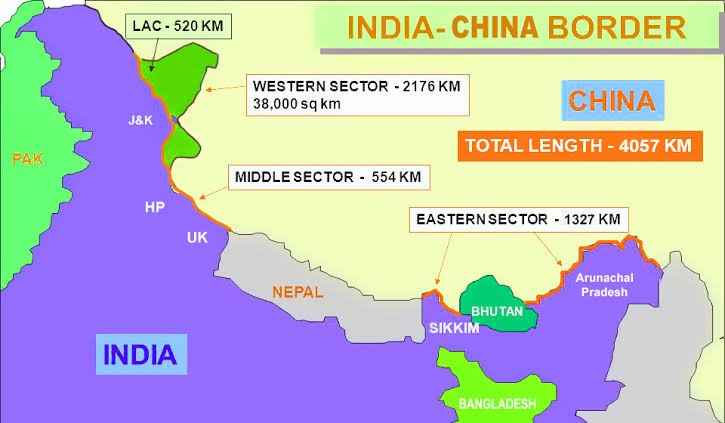India-China Relations: Complex Dynamics
Syllabus:
GS 2:
- International relations
- India and its neighbourhood relations.
Why in the News?
The 23rd meeting of Special Representatives (SRs) on the India-China boundary question was held in Beijing. While this regularized bilateral exchanges, it also exposed continuing differences and significantly lowered Indian expectations of a peaceful resolution.
Evaluating India-China Relations
- Diverging Statements: Indian statements are marked by brevity, focusing on frictions and disengagement processes, while Chinese statements remain expansive, often framing outcomes more positively.
- Evolving Perspectives: Compared to earlier SR meetings, Indian statements reflect reduced optimism, signaling growing concerns over China’s commitment to resolving disputes.
- Boundary Management: India emphasizes using diplomatic and military mechanisms to maintain peace and tranquility along the LAC, moving away from promoting direct interactions between troops.
- Framework Concerns: While India seeks a mutually acceptable boundary settlement, the 2005 Agreement on Political Parameters is seen as weakened due to repeated violations by China.
- Strategic Patience: India’s disengagement process is seen as a defensive response, with China strategically driving Indian expectations to an all-time low.
Strategic Implications of India-China Relations
- Impact on Regional Stability: The strained ties between India and China impact peace and stability in South Asia, with potential ripple effects in neighboring countries like Nepal, Bhutan, and Bangladesh.
- India’s Global Image: Prolonged boundary issues could portray India as weak in handling territorial disputes, affecting its credibility as a rising global power.
- China’s Advantage: By maintaining pressure along the Line of Actual Control (LAC), China ensures that India diverts its focus from other critical areas such as the Indo-Pacific.
- Influence on Alliances: Uncertainty in India’s ability to counter China might undermine confidence among partners like the U.S., Japan, and Australia, impacting broader strategic alignments like QUAD.
- Economic Ramifications: Frequent border tensions hinder bilateral trade and investments, which are crucial for India’s economic growth and supply chain stability.
Lessons for India from Past Engagements
- Doklam Standoff (2017): This incident underscores the importance of persistent vigilance and avoiding complacency after temporary resolutions.
- 2020 Galwan Valley Clash: Highlighted the need for stronger military infrastructure and tactical preparedness along sensitive border areas.
- Disengagement Challenges: The disengagement process reveals how prolonged negotiations often allow China to dictate terms, undermining India’s position.
- Need for Strategic Patience: Past interactions show that hasty or reactionary moves can compromise long-term strategic objectives.
- Proactive Diplomacy: India must focus on building alliances and partnerships to counterbalance China’s growing influence, rather than relying solely on bilateral mechanisms.
India’s Diplomatic Strategy Post-2020
- Reducing Direct Contacts: India now prefers buffer zones to minimize troop interactions, reflecting caution against further escalations.
- Balancing Relations: While ensuring dialogue continuity, India must avoid overreliance on diplomatic mechanisms that yield limited results.
- Learning from Past Missteps: Events like Doklam (2017) and the 2020 transgressions highlight the need for sustained vigilance and preparedness.
- Leveraging Alliances: Stronger alignments with Western democracies and regional partners can deter China’s unilateral actions.
- Economic Decoupling: Reducing dependence on Chinese imports will serve as both a strategic and economic deterrent.
Challenges in Bilateral Engagement
- Chinese Violations: Frequent breaches of bilateral agreements, such as the 2005 Agreement, weaken the trust and foundation of peaceful resolution efforts.
- Asymmetry in Expectations: India often approaches boundary discussions with a focus on de-escalation, while China maintains an upper hand by dictating terms.
- Reactive Diplomacy: Indian responses are often seen as reactionary rather than proactive, allowing China to consolidate its territorial gains.
- Pressure on Allies: India’s inability to assertively counter China raises doubts among its partners, such as the U.S., Japan, and Australia, regarding its reliability in the Indo-Pacific strategy.
- Long-Term Implications: The lack of a firm stance risks normalizing buffer zones and eroding India’s claims along the disputed boundary areas.
Way Forward
- Strengthen Deterrence: India must adopt a like-for-like strategy, strengthening its military and diplomatic posture to counter China’s assertiveness.
- Focus on Agreements: Reaffirming and ensuring compliance with existing treaties, such as the 2005 Agreement, will help rebuild trust.
- Engage Multilaterally: Collaborate with like-minded countries in forums like QUAD to counterbalance China’s regional influence.
- Sustain Diplomatic Pressure: Maintain consistent political and economic pressure, avoiding complacency in negotiations for short-term gains.
- Strategic Communication: Clearly articulate red lines and foster transparency in public and diplomatic engagements to strengthen India’s position globally.
Conclusion
The India-China bilateral relationship remains strained despite regular dialogues. China’s strategic patience and assertiveness have placed India on the backfoot. To safeguard its territorial integrity and uphold its sovereignty, India must recalibrate its diplomatic, military, and economic strategies for long-term resilience.
Source: Indian Express
Mains Practice Question
Evaluate the current status of India-China relations with a focus on the boundary question. Discuss the challenges in addressing this issue and suggest measures to strengthen India’s strategic position.





